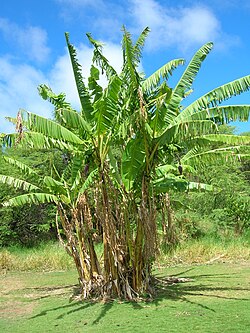The "banana-families" [1] [2] or banana group [3] [4] is a basal paraphyletic assemblage in the order Zingiberales (Monocotyledoneae) that comprises Musaceae (the banana family), Lowiaceae, Strelitziaceae, and Heliconiaceae. [1] [2] These taxa differentiate from the "ginger-families" derived clade by their plesiomorphic state of five or six fertile stamens, [1] [2] [5] and generally have large banana-like [1] [2] leaves that are easily torn [5] between secondary veins.
Morphologically, this is a more homogeneous group than the "ginger-families" clade. [2] In the past the banana families were often combined into the single family Musaceae. [3] [1] [2]
- Banana-families
- Musa (Musaceae)
- Ensete (Musaceae)
- Ravenala madagascariensis (Strelitziaceae)
- Strelitzia (Strelitziaceae)
- Heliconia (Heliconiaceae)
- Orchidantha (Lowiaceae)




